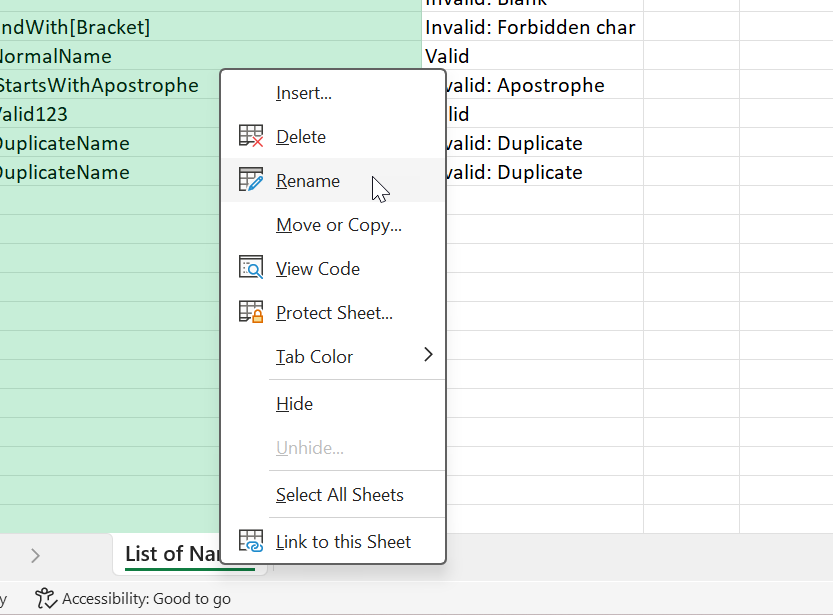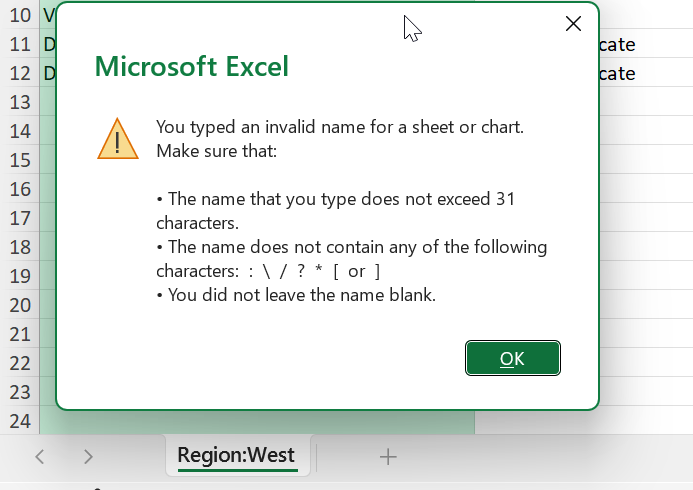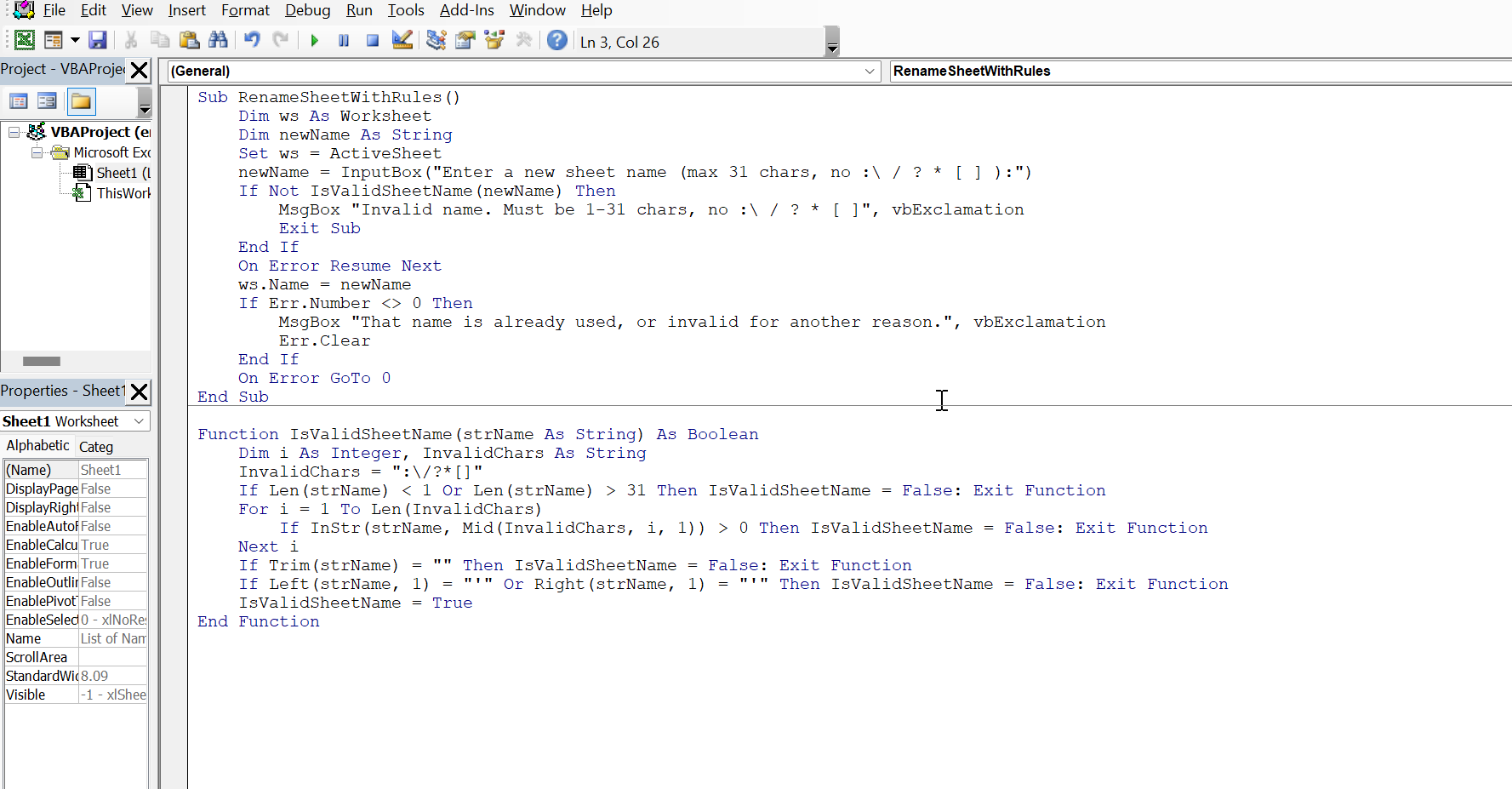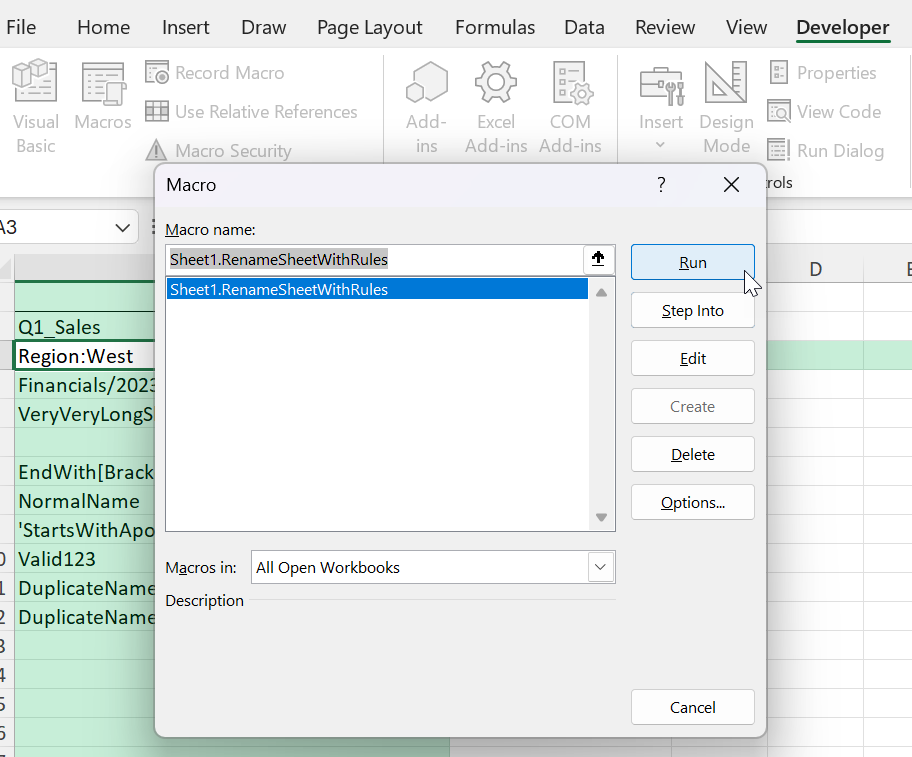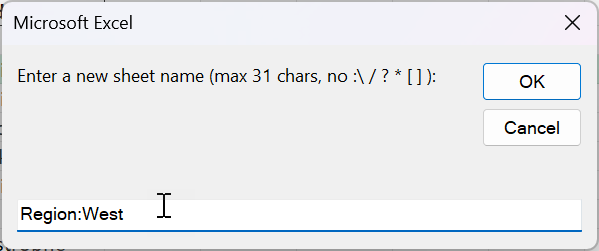When you’re sharing workbooks, building templates, or running automations, keeping sheet names consistent and compliant with Excel’s rules is critical. Excel restricts certain characters, length, and duplication in worksheet names. Enforcing Excel sheet naming rules saves you from errors, broken links, or failed VBA scripts. This guide covers everything you need to keep sheet names clean and valid using built-in Excel features, formulas, helper sheets, and VBA solutions.
Key Takeaways
- Sheet names in Excel can be up to 31 characters and must be unique within a workbook.
- Sheet names cannot contain these characters:
:\ / ? * [ ]. - Built-in error messages prevent most invalid names, but you can use formulas or VBA to check names before renaming sheets.
- Automating sheet naming rules with VBA ensures data integrity for templates and workflows.
- Helper sheets and cell validation can guide users to enter valid names.
Table of Contents
About Excel Sheet Naming Rules
Excel’s rules for sheet names are strict:
- Maximum 31 characters
- No blank names
- No duplicate names (within the same workbook)
- No characters:
:\ / ? * [ ] - Cannot start or end with an apostrophe (
')
Violating these rules causes errors, which can interrupt your workflow, break formulas, or stop macros.
The Importance of Proper Sheet Naming in Excel
Enhancing Organization and Efficiency
Proper sheet naming in Excel is more than just a formality; it plays a pivotal role in ensuring that your workbooks are organized and efficient. When you label sheets clearly and consistently, it becomes much easier to navigate through complex documents. Logical naming conventions improve teamwork by enabling others to locate and understand data swiftly. An organized spreadsheet significantly reduces the risk of errors due to misinterpretation or confusion, which, in turn, boosts overall productivity.
Avoiding Common Errors
Avoiding common errors in Excel sheet naming is crucial for maintaining document integrity and functionality. Name conflicts and the use of invalid characters in sheet names can disrupt automated processes and lead to system errors. By adhering to Excel’s naming conventions, you prevent issues like broken formulas and macros, which often occur when sheets are erroneously named. Clear naming also prevents duplicated efforts when team members spend less time deciphering the workbook’s structure. Implement consistent guidelines from the start to avoid these pitfalls.
How to Enforce Excel Sheet Naming Rules
Step 1: Manually Rename Sheets (and See Excel’s Warnings)
Right-click any sheet tab, choose Rename, and enter your new name.
Excel will display an error message if you try to use an invalid name or character.
Step 2: Enforce Naming Rules with VBA
If you need to automate or restrict naming at scale, VBA is the best approach. Add this macro to your workbook:
Sub RenameSheetWithRules()
Dim ws As Worksheet
Dim newName As String
Set ws = ActiveSheet
newName = InputBox("Enter a new sheet name (max 31 chars, no :\ / ? * [ ] ):")
If Not IsValidSheetName(newName) Then
MsgBox "Invalid name. Must be 1-31 chars, no :\ / ? * [ ]", vbExclamation
Exit Sub
End If
On Error Resume Next
ws.Name = newName
If Err.Number <> 0 Then
MsgBox "That name is already used, or invalid for another reason.", vbExclamation
Err.Clear
End If
On Error GoTo 0
End Sub
Function IsValidSheetName(strName As String) As Boolean
Dim i As Integer, InvalidChars As String
InvalidChars = ":\/?*[]"
If Len(strName) < 1 Or Len(strName) > 31 Then IsValidSheetName = False: Exit Function
For i = 1 To Len(InvalidChars)
If InStr(strName, Mid(InvalidChars, i, 1)) > 0 Then IsValidSheetName = False: Exit Function
Next i
If Trim(strName) = "" Then IsValidSheetName = False: Exit Function
If Left(strName, 1) = "'" Or Right(strName, 1) = "'" Then IsValidSheetName = False: Exit Function
IsValidSheetName = True
End Function

This VBA solution prompts for a sheet name, checks the rules, and only applies valid names.
Common Mistakes and Tips
Mistake: Forgetting about length limit
Sheet names longer than 31 characters are rejected, even if other rules are followed.
Mistake: Including forbidden characters
Avoid :\ / ? * [ ] in all sheet names.
Tip: Check for duplicates before renaming
Use =COUNTIF(sheetList, newName) in a helper sheet if you have a list of all sheet names.
Tip: Use data validation and helper columns to guide users
Show immediate feedback on sheet name proposals.
Tip: Automate renaming with VBA for templates
Run validation every time a new sheet is created or renamed.
Bonus Tips and Advanced Scenarios
Power Query for Sheet Name Lists
Power Query can pull a list of all sheet names (from “Get Data from Workbook”), helping you track and audit naming compliance.
VBA for Bulk Renaming
Use a VBA macro to rename sheets based on a validated list in your workbook.
Dynamic Helper Sheet
Build a dashboard that tests each user proposal against all rules, using conditional formatting to highlight problems.
Practical Use Cases
Standardizing monthly or regional sheet naming in large organizations
Preparing Excel templates for teams with varying technical skill
Automating financial or project report generation by naming convention
Cleaning up old workbooks for compliance and automation
Preventing broken links in formulas, charts, or VBA due to sheet name errors
FAQ
Q: What is the maximum length for an Excel sheet name?
A: 31 characters.
Q: What characters are not allowed in Excel sheet names?
A: :\ / ? * [ ]
Q: Can two sheets have the same name in a workbook?
A: No, each sheet must have a unique name.
Q: How can I check a list of names for validity?
A: Use helper columns and formulas to check length and forbidden characters, as shown above.
Q: Can I automate sheet naming rules in Excel?
A: Yes, use VBA to enforce rules every time a sheet is created or renamed.
John Michaloudis is a former accountant and finance analyst at General Electric, a Microsoft MVP since 2020, an Amazon #1 bestselling author of 4 Microsoft Excel books and teacher of Microsoft Excel & Office over at his flagship MyExcelOnline Academy Online Course.

